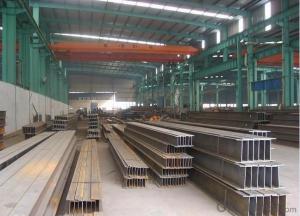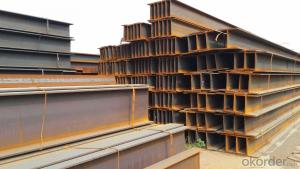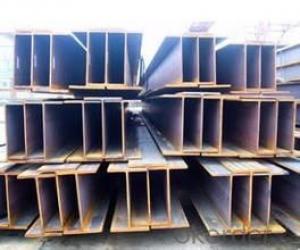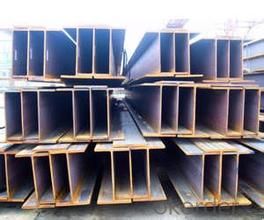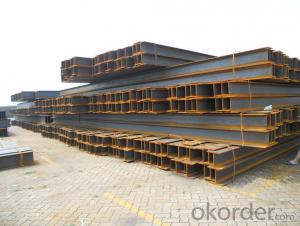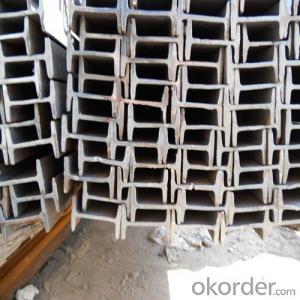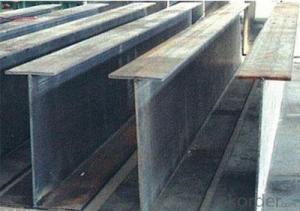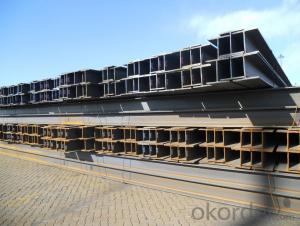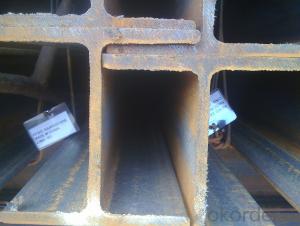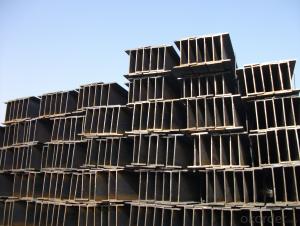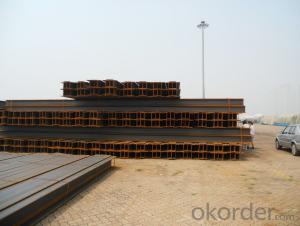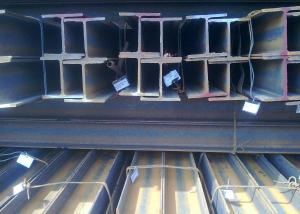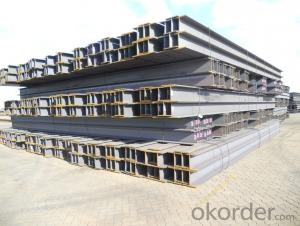Carbon steel H BEAM for construction JIS SS400
- Loading Port:
- Tianjin
- Payment Terms:
- TT or LC
- Min Order Qty:
- 25 m.t.
- Supply Capability:
- 100000 m.t./month
OKorder Service Pledge
OKorder Financial Service
You Might Also Like
Product Description:
OKorder is offering carbon steel H BEAM for construction JIS SS400 at great prices with worldwide shipping. Our supplier is a world-class manufacturer of steel, with our products utilized the world over. OKorder annually supplies products to European, North American and Asian markets. We provide quotations within 24 hours of receiving an inquiry and guarantee competitive prices.
Product Applications:
Carbon steel H BEAM are ideal for structural applications and are widely used in the construction of buildings and bridges, and the manufacturing, petrochemical, and transportation industries.
Product Advantages:
OKorder's H Beam are durable, strong, and resist corrosion.
Main Product Features:
· Premium quality
· Prompt delivery & seaworthy packing (30 days after receiving deposit)
· Corrosion resistance
· Can be recycled and reused
· Mill test certification
· Professional Service
· Competitive pricing
Product Specifications:
1. Standard: JIS 3192
2. Grade: SS400 or Equivalent
3. Length: 10m, 12m as following table
4. Invoicing on theoretical weight or actual weight as customer request
5.Payment: TT or L/C
Size and Mass of H beam:
| Size (mm) | Mass (Kg/m) | Size (mm) | Mass (Kg) |
| 198*99*4.5 | 17.8 | 194*150*6 | 29.9 |
| 200*100*5.5 | 20.9 | 200*200*8 | 49.9 |
FAQ:
Q1: How soon can we receive the product after purchase?
A1: Within three days of placing an order, we will begin production. The specific shipping date is dependent upon international and government factors, but is typically 7 to 10 workdays.
Q2: Can stainless steel rust?
A2: Stainless does not "rust" as you think of regular steel rusting with a red oxide on the surface that flakes off. If you see red rust it is probably due to some iron particles that have contaminated the surface of the stainless steel and it is these iron particles that are rusting. Look at the source of the rusting and see if you can remove it from the surface.
Images:
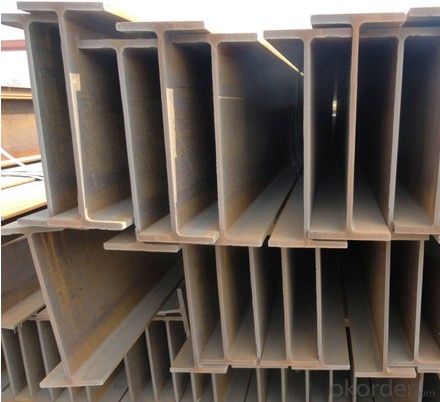
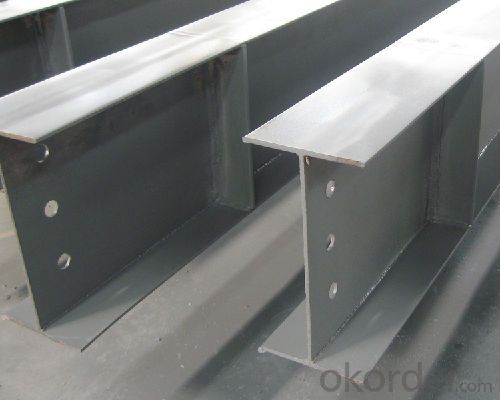
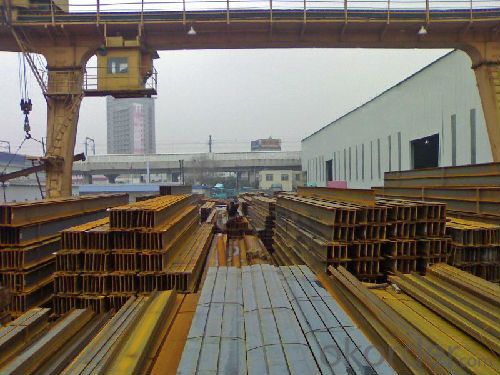
- Q: How do steel H-beams perform in dynamic loads?
- Steel H-beams are highly effective in withstanding dynamic loads due to their structural characteristics. The H-shaped cross-section of these beams provides excellent strength and rigidity, making them ideal for applications where dynamic forces are a concern. When subjected to dynamic loads, such as impact or vibrations, steel H-beams exhibit a high resistance to deformation and fatigue failure. Their shape allows for even distribution of the applied loads, which minimizes stress concentrations and prevents localized failure points. This makes them highly reliable and durable under dynamic conditions. Moreover, steel is known for its high strength-to-weight ratio, which means that H-beams can withstand significant dynamic loads while maintaining a relatively low weight. This not only simplifies the structural design but also reduces material and transportation costs. Steel H-beams also possess excellent elasticity, meaning that they can absorb and dissipate energy from dynamic loads, minimizing potential damage or deformation to the structure. This elasticity helps in reducing the amplitude of vibrations and prevents the propagation of stress waves throughout the beam. In summary, steel H-beams are well-suited for dynamic loads due to their structural integrity, high strength-to-weight ratio, and elasticity. They can effectively resist deformation, fatigue, and impact caused by dynamic loads while maintaining their structural integrity and durability.
- Q: How do steel H-beams perform in high-rise buildings?
- The construction of high-rise buildings often utilizes steel H-beams because of their exceptional performance under vertical loads and their ability to withstand high levels of tensile and compressive forces. These beams distribute the weight of the building evenly across their span, ensuring structural stability and support, ultimately allowing for the construction of taller and more efficient structures. A key advantage of steel H-beams in high-rise buildings is their impressive strength-to-weight ratio. This means they can bear heavy loads while remaining relatively lightweight, making them ideal for constructing tall buildings where weight reduction is crucial. Moreover, steel H-beams possess a high degree of flexibility, enabling them to bend and deform under extreme loads without compromising the overall integrity of the structure. Additionally, steel H-beams exhibit excellent fire resistance properties, which is particularly vital in high-rise buildings where fire safety is of utmost concern. Steel is inherently non-combustible and does not contribute to the spread of fire. Furthermore, these beams can be protected with fire-resistant coatings or encased in fire-resistant materials to enhance their fire resistance capabilities. In terms of construction efficiency, steel H-beams offer numerous benefits. They are prefabricated off-site, allowing for faster and more cost-effective installation. The manufacturing process ensures consistent quality and dimensional accuracy, which leads to reduced construction time and labor costs. This makes steel H-beams a popular choice for high-rise buildings where time and cost savings are critical factors. Another advantage of utilizing steel H-beams in high-rise buildings is their versatility. They can be easily customized and adapted to meet the specific design requirements of the structure. This flexibility allows architects and engineers to create innovative and aesthetically pleasing designs without compromising on structural integrity. Overall, steel H-beams are a reliable and efficient choice for high-rise buildings. Their high strength, fire resistance, construction efficiency, and versatility make them well-suited for withstanding the demanding conditions and loads experienced by tall structures.
- Q: How do steel H-beams perform in terms of torsion resistance?
- Steel H-beams possess excellent properties for resisting torsion. These beams have an H-shape design which aids in distributing the load evenly, resulting in a high level of resistance against torsion forces. The combination of horizontal flanges and vertical web in the beam effectively counteracts twisting and bending moments, ensuring structural stability and preventing deformation. Furthermore, the utilization of high-quality steel in H-beams further enhances their ability to withstand torsion, as steel is a robust and enduring material capable of enduring substantial forces without yielding or breaking. In general, steel H-beams are widely regarded as one of the top choices for applications that necessitate exceptional torsion resistance, such as constructing frames, bridges, and industrial structures.
- Q: Can steel H-beams be used in multi-story buildings?
- Yes, steel H-beams can be used in multi-story buildings. Steel H-beams are commonly used in construction due to their strength, durability, and load-bearing capabilities. They provide structural support and stability, making them an ideal choice for multi-story buildings. Additionally, steel H-beams can be easily fabricated and installed, allowing for efficient construction. Their versatility and ability to withstand heavy loads make them a popular choice among architects and engineers for constructing high-rise buildings.
- Q: How do steel H-beams contribute to waste reduction in construction?
- There are several reasons why steel H-beams play a significant role in waste reduction in construction. Firstly, these beams are incredibly strong and durable, ensuring that the structures they support have a longer lifespan. This means that there is less need for frequent repairs or replacements, resulting in less waste generated from these activities. Furthermore, steel H-beams can be easily recycled when they reach the end of their life cycle. When a building is demolished or renovated, the steel beams can be collected and sent to recycling facilities. Unlike other construction materials, steel can be recycled over and over again without losing its quality. By recycling steel H-beams, we can reduce the amount of waste that would otherwise end up in landfills. In addition, steel H-beams are lightweight compared to other construction materials like concrete or wood. This makes transportation and installation much easier and requires fewer resources and less energy. As a result, the environmental impact associated with transportation emissions is reduced, and there is less waste generated during the construction process. Moreover, steel H-beams offer a flexible and adaptable design solution. They can be easily modified, reconfigured, or reused in different projects. This adaptability reduces the need for new materials and decreases construction waste. It also allows for more sustainable practices, such as deconstructing and repurposing existing structures instead of demolishing them completely. In conclusion, steel H-beams contribute to waste reduction in construction through their durability, recyclability, lightweight nature, and adaptability. By using these beams, we can prolong the lifespan of structures, recycle materials at the end of their life cycle, reduce transportation emissions, and promote a more sustainable construction industry.
- Q: Are steel H-beams suitable for supporting gantry cranes?
- Indeed, steel H-beams are indeed appropriate for the purpose of supporting gantry cranes. These H-beams have been ingeniously designed to possess exceptional strength and load-bearing capacity, rendering them perfect for the task of supporting heavy machinery like gantry cranes. The unique shape of the H-beam enables a more effective distribution of weight, thereby ensuring stability and greatly reducing the likelihood of bending or collapsing under the crane's weighty load. Moreover, steel is a remarkably robust and enduring material, capable of withstanding the constant stress and strain exerted by the crane. Hence, utilizing steel H-beams as the foundational structure for gantry cranes is undoubtedly a dependable and secure choice.
- Q: Can Steel H-Beams be used in architectural features or decorative elements?
- Certainly, architectural features or decorative elements can definitely utilize Steel H-Beams. Although primarily known for their structural strength and load-bearing capabilities in construction, H-Beams can also be employed in architectural designs to create distinctive and visually pleasing features. Architects and designers have the ability to integrate H-Beams into the overall aesthetics of a building, such as exposed beam ceilings, mezzanines, or open floor plans. The contemporary and industrial appearance of steel H-Beams can contribute a modern touch to any space. Furthermore, H-Beams can be utilized to fashion decorative elements like staircases, railings, pergolas, or even furniture pieces. Their sleek lines and durable nature make them suitable for both indoor and outdoor applications. In addition to their aesthetic appeal, steel H-Beams offer practical advantages. They possess fire-resistant properties, durability, and require minimal maintenance. Their structural integrity guarantees long-lasting performance and can endure heavy loads, which makes them an ideal choice for architectural features and decorative elements. All in all, Steel H-Beams present a versatile and visually appealing option for incorporating architectural features or decorative elements into a design. Their strength and durability, combined with their modern and industrial appearance, make them an outstanding option for both functional and aesthetic purposes in the field of architecture.
- Q: Are there any regulations or standards for using steel H-beams in construction?
- Yes, there are regulations and standards for using steel H-beams in construction. These regulations and standards vary depending on the country and region, but they generally ensure the safe and effective use of H-beams in building structures. In the United States, the American Institute of Steel Construction (AISC) provides the main standards for steel construction, including H-beams. The AISC's Manual of Steel Construction outlines the design criteria, fabrication requirements, and safety considerations for using H-beams in various construction applications. These standards cover topics such as material specifications, design principles, welding procedures, and quality control measures. Similarly, in Europe, the European Committee for Standardization (CEN) has developed the Eurocodes, which provide a set of harmonized technical rules for the design of structures, including steel H-beams. The Eurocodes cover various aspects of construction, including structural design, material properties, and construction execution. The Eurocodes ensure that H-beams used in construction projects meet the required safety, performance, and durability standards. Other countries and regions may have their own specific regulations and standards for using steel H-beams in construction. These standards typically address issues like material properties, structural design criteria, fabrication and construction practices, and quality control measures. Contractors, engineers, and designers must comply with these regulations to ensure the structural integrity and safety of buildings using steel H-beams. It is important to consult the relevant local building codes and standards, as well as engage the services of qualified professionals, such as structural engineers, during the design and construction stages to ensure compliance with all applicable regulations and standards.
- Q: Can steel H-beams be used in commercial building facades?
- Yes, steel H-beams can be used in commercial building facades. These beams offer structural support and can be aesthetically pleasing when incorporated into the design. They provide durability, strength, and flexibility, making them suitable for commercial applications where large spans and vertical loads need to be supported.
- Q: Can steel H-beams be used in the construction of residential complexes?
- Yes, steel H-beams can be used in the construction of residential complexes. They are commonly used as structural supports due to their strength, durability, and ability to withstand heavy loads. H-beams provide structural integrity to buildings, making them suitable for residential complex construction projects.
Send your message to us
Carbon steel H BEAM for construction JIS SS400
- Loading Port:
- Tianjin
- Payment Terms:
- TT or LC
- Min Order Qty:
- 25 m.t.
- Supply Capability:
- 100000 m.t./month
OKorder Service Pledge
OKorder Financial Service
Similar products
Hot products
Hot Searches
Related keywords
